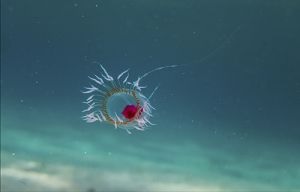
What is the immortal jellyfish? It is a jellyfish called Turritopsis dohrnii that can revert to a sexually immature stage in its life and theoretically live forever.
There are many organisms that are very long lived. There are plant organisms that are thousands of years old. A colony of quaking aspens is thought to be over 80,000 years old. However, most animals age and then die. We age because our cells cannot keep reproducing themselves. When we are born, we are made of young cells that reproduce themselves. Each cell has a programmed life expectancy, some being longer than others. When they die, new cells are produced to replace them. These cells are copies of the original cells. As we get older, it becomes harder to copy the cells exactly and genetic mutation and damage creeps in. One reason for this is that the protective caps at the end of our DNA, called telomeres, degrade and the DNA falls apart. Once we can’t reproduce our cells well enough, we start to die.
There are several ways that animals that live a long time can get around things like this. Animals like salamander can use stem cells to regrow pretty much any part of their body. They can even regrow parts of their brain and head, if they lose them. Then, there are animals, such as lobsters, that can fix the telomeres on their DNA. They have an enzyme called telomerase, which can fix and strengthen the telomeres on the ends of DNA. This means lobsters don’t really age. In fact, lobsters only die because they have an exoskeleton and they need to shed this and grow a new one each time they get larger. That requires a lot of energy, and that is what kills them in the end.
So, does the Turritopsis dohrnii get around aging? Well, it does age and it does get sick and it does actually die. And that is when the magic happens. The dead, decaying jellyfish sinks to the bottom of the sea and when it gets there, its cells regenerate and form polyps. Each one of those polyps can become a new jellyfish. It basically reverts to the form it is in when it is born. It would be like us getting injured and just becoming an embryo again. When the jellyfish is born, it starts out as a group of cells, which become larvae. These larvae attach to the seabed and become polyps. A polyp is basically a tube attached to the seabed at one end and with a mouth to eat with at the other. The polyps grows as it eats and when it is large enough, it breaks away from the seabed and becomes a baby jellyfish, which then grows into an adult jellyfish. When the jellyfish is injured, it does all of this again. Out of the dying jellyfish, a piece of tissue is released, which attaches itself to the seabed. This piece of tissue slowly becomes a polyp, and the whole process repeats itself. Technically, they can do this forever. Experiments have shown that the jellyfish do this when they are starved, injured, subjected to intense temperature, and put into less salty water.
The Turritopsis dohrnii is able to do this because it can change its cells. In our bodies, hair cells are always hair cells and liver cells are always liver cells. When we are babies, we have stem cells that can become any cell, but we produce fewer of those as we age. This jellyfish is able to take its adult cells and repurpose them as juvenile cells. It does it by inverting its cap, the umbrella part of the jellyfish. Then it absorbs its tentacles and all of the umbrella, becoming a small bunch of cells. These cells change into the juvenile cells and become polyps when they attach to the seabed.
Scientists are studying this jellyfish with great interest. It is not likely that we will be able to do something so amazing, but there could be things that medical science can use. If they can find out how the jellyfish is able to make its cells change from one form to another without going through a stem cell phase, then maybe we could use it to make some of our cells become heart cells, or liver cells, or whatever we needed. Still, anything like that is probably a long way off. And this is what I learned today.
Image By Bachware – Own work, CC BY-SA 4.0, https://commons.wikimedia.org/w/index.php?curid=48971787
Sources
https://www.age.mpg.de/how-do-we-age
https://www.science.org.au/curious/earth-environment/animals-can-live-forever
https://en.wikipedia.org/wiki/Turritopsis_dohrnii
https://www.unsw.edu.au/newsroom/news/2022/09/what-lobsters-can-teach-us-about-immortality
https://web.archive.org/web/20100402085711/http://8e.devbio.com/preview_article.php?ch=2&id=6
